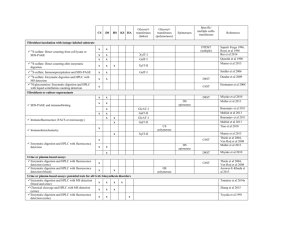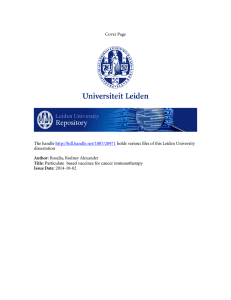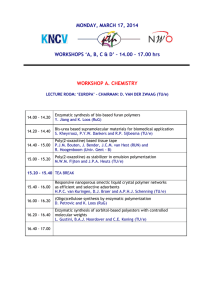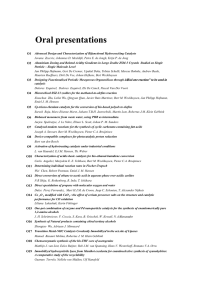Hoofdstuk 7 - Dissertations
advertisement
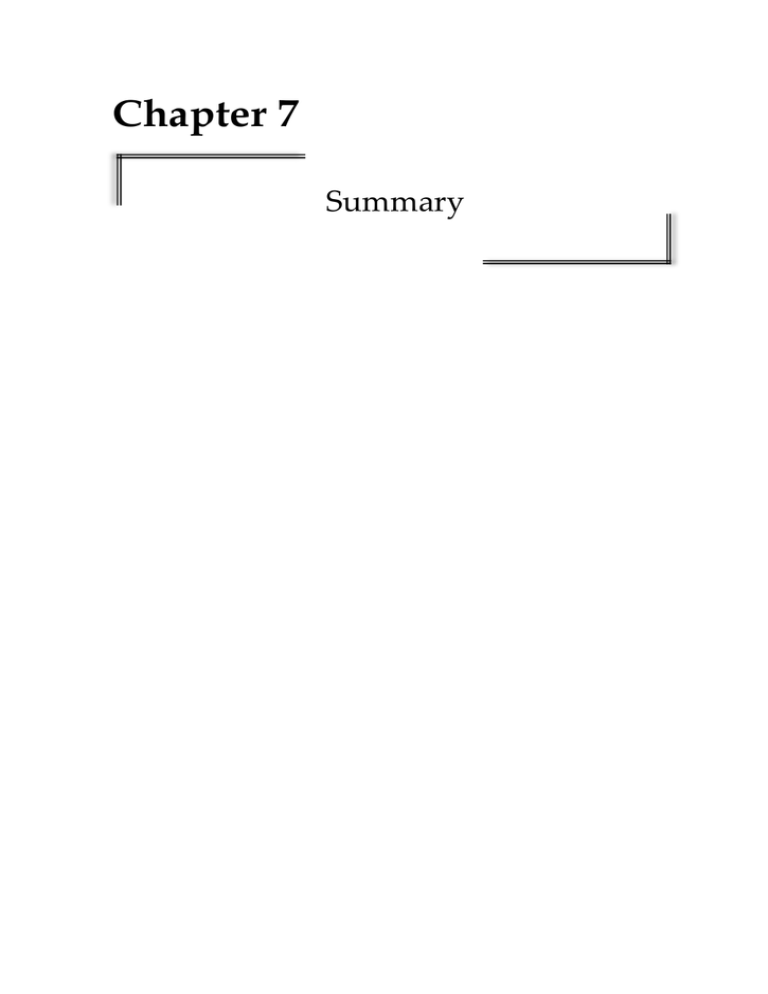
Chapter 7 Summary Chapter 7 Enzymes are proteins with catalytic activity that control the rates of metabolic processes in living cells. The selective and specific features of enzymes have drawn an enormous amount of attention for using enzymes as in vitro catalysts in polymerization reactions. The use of enzymes offers many advantages, such as reducing the need for extensive protection and deprotection steps in complicated reactions and preventing undesired by-products. Furthermore, using enzymes in organic solvents leads to new types reactions that are not feasible with conventional chemistry (e.g., synthesis of novel monomers, oligomers, or polymers). Developments in enzymatic polymerization have been ongoing for decades. Various studies on enzymatic synthesis of polyesters, polycarbonates, polysaccharides, polypeptide, and polyamide have been performed and some of them have been implemented on an industrial scale. Lipases are the most used catalyst in the synthesis of polyesters and polyamides. Extensive studies on the kinetics and the mechanism(s) of lipase-catalyzed synthesis of polyesters have been carried out already, but the enzymatic synthesis of polyamides has received less attention. Therefore, the thesis aims to address this by focusing more on the enzymatic synthesis of polyamides in order to get a better understanding on its reaction mechanism. As an introduction to the field of enzymatic catalysis, Chapter 1 provides a brief description of the use of enzymes in organic solvents, two different enzymes that were used in this research (Candida antarctica lipase B (CAL-B) and Fusarium solani pisi cutinase), and the immobilization of these enzymes. An overview of recent developments in enzymatic synthesis of polyamides and its copolymers is also discussed. In enzymatic polymerizations, the use of enzymes is limited due to the low stability of enzymes in organic solvents and high reaction temperature compared to the working temperature of enzymes in metabolic reactions. Immobilization is one of the methods that can be used to improve the stability of enzymes. The immobilization of Fusarium solani pisi cutinase is described in Chapter 2. Three different methods were investigated for the cutinase immobilization: via physical adsorption to Lewatit beads, covalent linkage to modified Eupergit CM beads, or with cross-linked enzyme aggregate (CLEA). Studies on the synthetic and hydrolytic activities of the immobilized cutinase revealed that CLEA cutinase showed higher activities compared to the cutinases immobilized on either Lewatit or Eupergit CM. In combination with the straightforward preparation method and the reasonable catalytic activity, the CLEA method is the preferred method to immobilize cutinase. 120 Summary The use of immobilized cutinase as a catalyst in the synthesis of polyesters has been reported previously, but its use as catalyst in the synthesis of polyamides is a relatively new avenue of research. In Chapter 3, the enzymatic synthesis of nylon-4,10, nylon-6,10, and nylon-8,10 are discussed. The synthesis was carried out via polycondensation of different diamines (1,4diaminobutane, 1,6-hexanediamine, or 1,8-diaminooctane) and diethyl sebacate using immobilized cutinase on Lewatit, CLEA cutinase, or CAL-B as catalyst. In comparison with the commercially available immobilized CAL-B, CLEA cutinase shows good catalytic activity in the synthesis of nylons, like CAL-B. Both, cutinase and CAL-B exhibit high selectivity and catalytic activity toward diamines with longer chains (C8 > C6 > C4). In Chapter 4, a series of enzymatic reactions with -aminocarboxylic acids (4-aminobutanoic acid, 5-aminovaleric acid, 6-aminocaproic acid, and 8aminooctanoic acid) were examined. This study has shown that CAL-B is able to catalyze the formation of lactams with different ring sizes. Cyclization of 6aminocaproic acid to -caprolactam resulted in moderate yields of approximately 60% after 5 days. Other lactams such as butyrolactam, valerolactam as well as, dimer and trimer lactams can be formed from enzymatic reactions of 4-aminobutanoic acid, 5-aminovaleric acid, and 8aminooctanoic acid. Reactions with mixtures of the individual aminocarboxylic acids showed that CAL-B prefers homocyclization of the aminocarboxylic acids therefore preventing the formation of mixed macrocyclic lactams. The study on the enzymatic synthesis of aliphatic-aromatic oligoamides is described in Chapter 5. The enzymatic synthesis of oligo(p-xylylene sebacamide) and oligo(octamethylene terephthalamide) were successfully performed using CAL-B, immobilized cutinase on Lewatit, or CLEA cutinase as catalyst. Oligo(p-xylylene sebacamide) was synthesized after reaction of pxylylene diamine (p-XD) and diethyl sebacate. Oligo(octamethylene terephthalamide) was produced from the reaction of 1,8-diaminooctane and dimethyl terephthalate (DMTP). The highest conversion of oligo(p-xylylene sebacamide) (50%) was achieved using CAL-B as catalyst. Even though reactions using CLEA cutinase as catalyst showed lower conversion, they did result in the comparable or higher degrees op polymerization (DPmax). This clearly indicates the potential of CLEA cutinase in enzymatic polymerizations. The reaction of the aromatic diamine and diester (p-XD and DMTP), using either CAL-B or CLEA cutinase as catalyst, only resulted in short chain amide products due to the bulkiness of the monomers. 121 Chapter 7 Kinetic studies and research on the mechanism(s) of lipase-catalyzed ringopening polymerization (ROP) of -caprolactone (-CL) and -lactam have been performed previously. The results have shown that the reaction mechanism of -lactam proceeds via different routes compared to the reaction mechanism of ROP of -CL. By combining the ROP of -CL and -lactam in a one-pot reaction, a new type of polyester amide was synthesized and is discussed in Chapter 6. Poly(-CL-co--lactam) was successfully synthesized by enzymatic ring-opening copolymerization of -CL and -lactam using CAL-B as catalyst. The structures of poly(-CL-co--lactam) were observed in the form of both alternating and random copolymers. The random copolymer contains alternating repeating units with short oligo(-CL) or oligo(-lactam) segments. By varying the feed ratios of -CL/-lactam (75:25, 50:50, and 25:75), the alternating and the random copolymer can still be observed in the different distributions. The alternating copolymer is the most abundant structure and can be observed in the poly(-CL-co--lactam) resulting from the copolymerization of 50:50 -CL/lactam. A proposed reaction mechanism of the formation of the alternating and random copolymer is presented in chapter 6. 122 Samenvatting Samenvatting Enzymen zijn proteïnen met katalytische activiteit, die de snelheden van stofwisselingsprocessen in levende cellen controleren. De selectieve en specifieke aspecten van enzymen hebben zeer veel aandacht getrokken, met name om enzymen als in vitro katalysatoren te gebruiken in polymerisatie reacties. Het gebruik van enzymen levert vele voordelen op, zoals het verminderen van de behoefte aan uitgebreide beschermingsstappen en stappen om de bescherming weer op te heffen in gecompliceerde reacties en het voorkomen van ongewenste bijproducten. Verder leidt het gebruik van enzymen in organische oplosmiddelen tot nieuwe soorten reacties, die niet mogelijk zijn met conventionele chemie (bijv. de synthese van nieuwe monomeren, oligomeren of polymeren). Ontwikkelingen in enzymatische polymerisaties zijn al tientallen jaren aan de gang. Verschillende studies over enzymatische syntheses van polyesters, polycarbonaten, polysachariden, polypeptiden en polyamides zijn uitgevoerd en sommigen ervan zijn op industriële schaal in gebruik genomen. Lipases worden meestal als katalysator in de syntheses van polyesters en polyamides gebruikt. Uitgebreide studies naar de kinetiek en het mechanisme van lipase gekatalyseerde syntheses van polyesters zijn al uitgevoerd, maar de enzymatische syntheses van polyamides kreeg minder aandacht. Daarom richt dit proefschrift zich hierop, door zich meer te concentreren op de enzymatische syntheses van polyamides, dit om een beter begrip te krijgen van het reactiemechanisme ervan. Als inleiding op de enzymatische katalyse geeft Hoofdstuk 1 een korte beschrijving van het gebruik van enzymen in organische oplosmiddelen, over twee verschillende enzymen die gebruikt werden in dit onderzoek (Candida antarctica lipase B (CAL-B) en Fusarium solani pisi cutinase) en de immobilisatie van deze enzymen. Een overzicht van recente ontwikkelingen in enzymatische syntheses van polyamides en de copolymeren ervan wordt ook besproken. In enzymatische polymerisaties is het gebruik van enzymen beperkt ten gevolge van de lage stabiliteit van enzymen in organische oplosmiddelen en de hoge reactie temperatuur vergeleken met de temperatuur waarbij de enzymen werken in stofwisselingsreacties. Immobilisatie is één van de methoden die gebruikt kunnen worden om de stabiliteit van de enzymen te verbeteren. De immobilisatie van Fusarium solani pisi cutinase wordt beschreven in Hoofdstuk 2. Drie verschillende methoden werden onderzocht om de cutinase te immobiliseren: via fysische adsorptie aan Lewatit hars, covalente binding aan gemodificeerde Eupergit CM hars, of met het vernette enzym aggregaat 124 Samenvatting (CLEA). Studies naar de synthetische en hydrolytische activiteit van het geïmmobiliseerde cutinase toonden aan, dat CLEA cutinase hogere activiteit liet zien vergeleken met de cutinases, die geïmmobiliseerd waren zowel aan Lewatit als aan Eupergit CM. In combinatie met de recht toe recht aan bereidingsmethode en de redelijke katalytische activiteit wordt de voorkeur gegeven aan de CLEA methode om cutinase te immobiliseren. Het gebruik van geïmmobiliseerde cutinase als katalysator in de synthese van polyesters is al eerder beschreven, maar het gebruik ervan als katalysator in de synthese van polyamides is een relatief nieuwe route in het onderzoek. In Hoofdstuk 3 wordt de enzymatische synthese van nylon-4,10, nylon-6,10 en nylon-8,10 besproken. De synthese werd uitgevoerd via polycondensatie van verschillende diamines (1,4-diaminobutaan, 1,6-hexaandiamine, of 1,8diaminooctaan) en diethyl sebacaat, waarbij als katalysator gebruik gemaakt werd van Lewatit, CLEA cutinase, of CAL-B. In vergelijking met de commercieel verkrijgbare geïmmobiliseerde CAL-B, laat CLEA cutinase goede katalytische activiteit zien in de syntheses van nylons, net zoals CAL-B. Zowel cutinase als CAL-B tonen een hoge selectiviteit en katalytische activiteit ten opzichte van diamines met langere ketens (C8 > C6 > C4). In Hoofdstuk 4 werd een serie van enzymatische reacties met ωaminocarbonzuren (4-aminobutaanzuur, 5-aminovaleriaanzuur, 6aminohexaanzuur en 8-aminooctaanzuur) onderzocht. Deze studie heeft aangetoond dat CAL-B in staat is de vorming van lactam met verschillende ringgroottes te katalyseren. Cyclisatie van 6-aminohexaanzuur tot ε-caprolactam resulteerde in matige opbrengsten van ongeveer 60% na 5 dagen. Andere lactamen zoals butyrolactam, δ-valerolactam, zowel als dimeer en trimeer lactamen, kunnen worden gevormd via enzymatische reacties van 4aminobutaanzuur, 5-aminovaleriaanzuur en 8-aminooctaanzuur. Reacties met mengsels van de individuele aminocarbonzuren toonden aan dat CAL-B de voorkeur geeft aan de vorming van ringen van de afzonderlijke aminocarbonzuren en daardoor de vorming van gemengde macroringvormige lactamen verhindert. De studie van de enzymatische synthese van alifatische-aromatische oligoamides wordt beschreven in Hoofdstuk 5. De enzymatische synthese van oligo(p-xylyleen sebacamide) en oligo(octamethyleen terephtaalamide) werden succesvol uitgevoerd met het gebruik van CAL-B, op Lewatit geïmmobiliseerde cutinase of CLEA cutinase als katalysator. Oligo(p-xylyleen sebacamide) werd gesynthetiseerd via de reactie van p-xylyleen diamine (p-XD) met diethyl sebacaat. Oligo(octamethyleen terephtaalamide)werd gemaakt via de reactie van 125 Samenvatting 1,8-diaminooctaan met dimethyltereftalaat (DMTP). De hoogste conversie aan oligo(p-xylyleen sebacamide) (50%) werd verkregen met het gebruik van CALB als katalysator. Hoewel reacties waar gebruik gemaakt wordt van CLEA cutinase als katalysator lagere conversies laten zien, leverden deze reacties vergelijkbare of hogere polymerisatiegraden (DPmax) op. Dit laat duidelijk de potentie zien van CLEA cutinase in de enzymatische polymerisaties. De reactie van de aromatische diamine met de diester (p-XD en DMTP), gebruik makend van zowel CAL-B als CLEA cutinase als katalysator, resulteerde slechts in korte keten amide producten vanwege de grootte van de monomeren. Kinetische studies en onderzoek naar het mechanisme (of mechanismen) van lipase gekatalyseerde ring openings polymerisaties (ROP) van ε-caprolactam (εCL) en β-lactam zijn al eerder gedaan. De resultaten toonden aan dat het reactiemechanisme van β-lactam voortgang vindt via verschillende routes vergeleken met het reactiemechanisme van ROP voor ε-CL. Door de ROP van ε-CL en β-lactam te combineren in een één staps reactie, werd een nieuw type polyesteramide gesynthetiseerd en dit wordt besproken in Hoofdstuk 6. Poly(εCL-co-β-lactam) werd succesvol gesynthetiseerd door enzymatische ring openings copolymerisatie van ε-Cl en β-lactam, gebruik makend van CAL-B als katalysator. De structuur van poly(ε-CL-co-β-lactam) werd zowel in de vorm van een alternerende als een random copolymeer waargenomen. Het random copolymeer bevat alternerende eenheden met korte oligo(ε-CL) of oligo(βlactam) segmenten. Door de verhouding in de voeding van ε-CL/β-lactam te variëren (75:25, 50:50 en 25:75) kon het alternerende en random polymeer nog steeds worden waargenomen in de verschillende samenstellingen. Het alternerende copolymeer is de meest voorkomende structuur en kan waargenomen worden in poly(ɛ-CL-co-β-lactam) uit de copolymerisatie van 50:50 ɛ-CL/β-lactam. In hoofdstuk 6 wordt een reactiemechanisme voor de vorming van het alternerende en random copolymeer gepresenteerd. 126 Acknowledgements Acknowledgements Alhamdulillah, all praises for Allah… The journey as a PhD student has come to an end and I would like to dedicate these pages to all the people who supported me during the past four years of my PhD research. Therefore, I would like to express my deepest appreciation to everyone who provided me the possibility to complete this thesis. Foremost, I would like to express my sincerest gratitude to my supervisor, Prof. Katja Loos, who has supported me throughout my research with her patience, guidance, enthusiasm, and immense knowledge. Dear Katja, thank you very much for the opportunity to work with you during this PhD project and the Master Sandwich program. It has been a great experience for me and I have learned a lot from you during the entire process. I would like to thank you also for the countless valuable discussions and suggestions during my manuscript preparation. Without your help this thesis would not have existed. I would like to thank the members of the reading committee: Prof. Nico Bruns from Adoplhe Merkle Institute, Prof. Gregor Fels from University of Paderborn, and Prof. Francesco Picchioni from University of Groningen, for their time and effort they spent to asses this thesis. This research was supported by an Ubbo Emmius Scholarship program. I also would like to thank Novozymes (Denmark), CLEA Technology (The Netherlands), ChiralVision (The Netherlands), and Lanxess (Belgium) for supplying samples throughout this research project. I am most grateful to the committee members of the Master Sandwich program Institute Teknologi Bandung (ITB) – Zernike Institute for Advanced Materials, especially to Prof. Thom Palstra and Prof. Katja Loos for the opportunity to perform my master research at the University of Groningen. Many thanks to Prof. Arend Jan Schouten and Prof. Ton Loontjes for all the suggestions and comments regarding my research during the group meetings. I would also like to thank Prof. Gerrit ten Brinke and Prof. Andreas Herrmann, for all interesting lectures about polymer chemistry. I am utterly grateful to Gert Alberda van Ekenstein for his help with numerous DSC and TGA measurements, valuable discussions, preparing the Dutch summary for my thesis, and not to mention the great experience of writing manuscripts together. Dear Gert, thank you very much for everything. A very special thanks goes out to Albert Woortman. Without your GPC measurements, my last chapter and also our manuscript would not have been completed. Dear Albert, many thanks to you for helping me with proof-reading 128 Acknowledgements my thesis summary and it was a great pleasure working with you. You are the most wanted person for GPC measurements. Joop Vorenkamp deserves a special thank for his assistance with FTIR measurements. Thank you so much Joop, the start of my research project has become easier with your help. I would like to thank all the current and former members of the Polymer Chemistry Department. Special thanks to Karin, Hinke, Yvonne, and Martine, for helping me a lot with all the paperwork. Thanks to Lia ATWA and Rachmawati for all the help they provided during my master sandwich and PhD research. For all the great times we had during lunch and traveling together, hatur nuhun pisan. Thanks to Wouter Kloosterman for your guidance throughout my master sandwich program. Thanks to Leendert for training regarding the synthesis of the -propiolactam ring. All your suggestions on the topic of enzymatic polymerizations were clearly valuable for my research. To Kamlesh, thank you for all the stories, positive energy, motivation, and also the proof-reading of my thesis. Thanks to my dear Salomeh for the fruitful talks and your help with all the thesis-related things, I wish you a successful career in the future. Thanks to Qiuyan, for all the chats during the breaks and great times we had at the winter school. Thanks to Zheng for all the funny stories and all the suggestions about academic career. Thanks to Ralph for proof-reading my thesis. Many thanks for Vincent for kindly helping me with the proof-reading of my propositions, manuscripts and thesis. I cannot thank you enough for all your help. I would also like to thank Dejan for teaching me how to operate MALDIToF MS. Dear Dejan, it was a great experience for me to work with you. Thanks a lot for the lessons about PDB Viewer, fruitful discussions, and also your valuable contributions to my thesis. To the one and only student I had during my PhD research, Riana, thank you so much for our friendship. Your hard work became a valuable part of my thesis. Super special thanks to my office mate, Jelena Ciric Jokovic, you have been one of my best friends for the past four years. I feel warmly welcome by you, your friends, and your family. Thank you so much that you have always been there for me on special moments, especially when I needed someone to talk to, and when I needed an extra life for Candy Crush. I wish you all the best for the future and don’t forget to visit me again in Indonesia. Not forget to mention, to Jur, Nemanja, Milica, Ivana, Jaroen, Martin, Thu, Frans, Wendy, Sander, Nico, Hilde, Andreas, Minseok, Agniezka, Jan Willem, 129 Acknowledgements Deepak, Alina, Anke, Pavlo, Guiseppe, Alessio, Diego, Carla, Laura, Jin, Yi, Yexing, Jingyi, Jie, Lifei, Meng, Mark, Patrick, Nanda, Marijon, Martijn, Niels, Anton, Jacob and Steven, thank you! Groningen is like a second home to me and it would not have been that pleasant without all my friends. I am grateful and proud to be part of deGromiest (Indonesian Muslim Community in Groningen) and PPI Groningen (Indonesian Student Association in Groningen). Special thanks to Ka Robby, Pa Ali Rohman, Fahri, Ka Insanu, Ka Nizar & Ka Prita, Teh Susan & Ka Bino, Ka Muizz & Teh Sri, Pa Intan & Teh Enci, Ka Wahono & Dini, Teh Alia & Ka Izul, Teh Faizah & Ka Pandji, Ka Bintoro, Widi, Mba Nieke & Mas Donny, Teh Uyung, Teh Neng, Mba Ari, Mba Puri, Habib, Irfan & Liza, Desti & Ka Iging, Teh Puti & Ka Amel, Ka Guntur & Teh Intan, Mba Lia & Mas Yayok, Ka Fean, Amalina & Azis, Fikri, dan tentunya teman-teman Master sandwich program (Devi, Henny, Rafki, Elsye, Octia, Radi, Sofi, Febrina, Amalina, Tomi, Ulfah, Liany, Ali, Praw, Ren-ren, Dina, Masyitha, Raissa, Bibit, Aisyah and Nadya), teman-teman di Tekim (Mba Jenny, Ka Yusuf, Ria, Louis, Erna, Mba Laura, Angela, and Boy Fachri). Terima kasih banyak kepada keluarga besar deGromiest dan seluruh rekan-rekan PPIG yang namanya tidak mungkin saya sebutkan satu per satu, keberadaan teman-teman semua membuat hari-hari saya di Groningen makin berwarna dan bermakna. Kepada sahabat seperjuangan, Rizqiya Astri dan Daniel, terima kasih banyak atas dukungan, bantuan, dan menjadi teman yang baik untuk berbagi cerita. Terima kasih banyak untukmu sahabatku, Enny, Ratih, Iis, Hani, dan Veli yang meski jauh di mata tetapi selalu dekat di hati. Most of all, I would like to thank my family for their love and support throughout my entire life. Kepada Mamah dan Bapak, Alhamdulillah sekolah Ena udah beres. Terima kasih yang tidak berhingga atas pengorbanan, doa, dan dukungan yang tidak pernah putus buat Ena dan Ka Iqbal. Buat Teh Flori & A Sandra, Veratri, Roby, Sabrita, Rubi, dan Roji, Ena juga berterima kasih setulus hati. Juga, terima kasih banyak kepada Ibu, Bapak, dan Radi di Cimahi, atas dukunganmu untuk kami di perantauan. Ultimate thanks to my beloved husband, Iqbal. Hatur nuhun pisan ya sudah menjadi suami yang sabar, segala bisa, dan selalu ada di kala sedih dan senang. Penelitian saya jadi lebih mudah karena dibantu Ka Iqbal. Saya belajar banyak dari Ka Iqbal. Terima kasih banyak ya Ka.. Last but not least, best wishes for all of you who read these pages, whether you are listed above or not. Thank you 130 List of publications Stavila, E.; Loos, K. Synthesis of lactams using enzyme-catalyzed aminolysis, Tetrahedron Lett. 2013, 54, 370-372. Stavila, E.; Arsyi, R. Z.; Petrovic, D. M.; Loos, K. Fusarium solani pisi cutinase-catalyzed synthesis of polyamides, Eur. Polym. J. 2013, 49, 834842. Stavila, E.; Alberda van Ekenstein, G. O. R.; Loos, K. Enzyme-catalyzed synthesis of aliphatic-aromatic oligoamides, Biomacromolecules 2013, 14, 1600-1606. Stavila, E.; Alberda van Ekenstein, G. O. R.; A. J. J. Woortman; Loos, K. Lipase-catalyzed ring-opening copolymerization of -caprolactone and lactam, Biomacromolecules 2014, 15, 234-241. Stavila, E.; Loos, K. Synthesis of polyamides and their copolymers via enzymatic polymerization, submitted. Kloosterman, W. M. J.; Roest, S.; Priatna, S. R.; Stavila, E.; Loos, K. Chemoenzymatic synthesis route to poly(glucosyl-acrylates) using glucosidase from almonds, Green Chem. 2014, Advance Article, DOI: 10.1039/C3GC41115J. Aslan, Y.; Handayani, N.; Stavila, E.; Loos, K. Improved performance of Pseudomonas fluorescens lipase by covalent immobilization onto Amberzyme, Turk J Biochem. 2013, 38, 313–318. Aslan, Y.; Handayani, N.; Stavila, E.; Loos, K. Covalent immobilization of Pseudomonas fluorescens lipase onto Eupergit CM, Int. J. Curr. Res. 2014, 6, 5225-5228. 132
